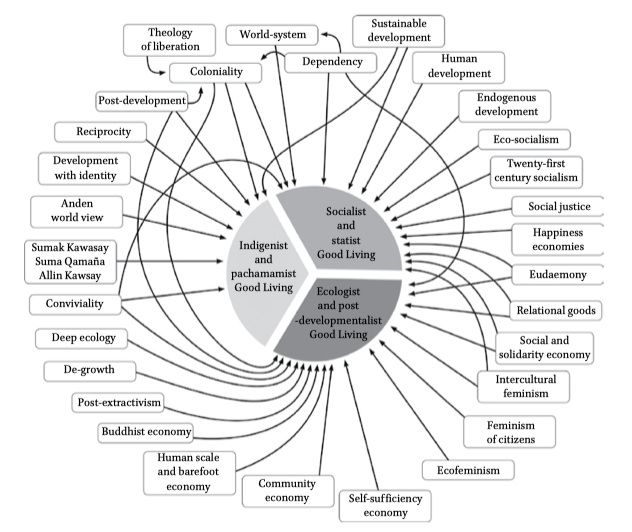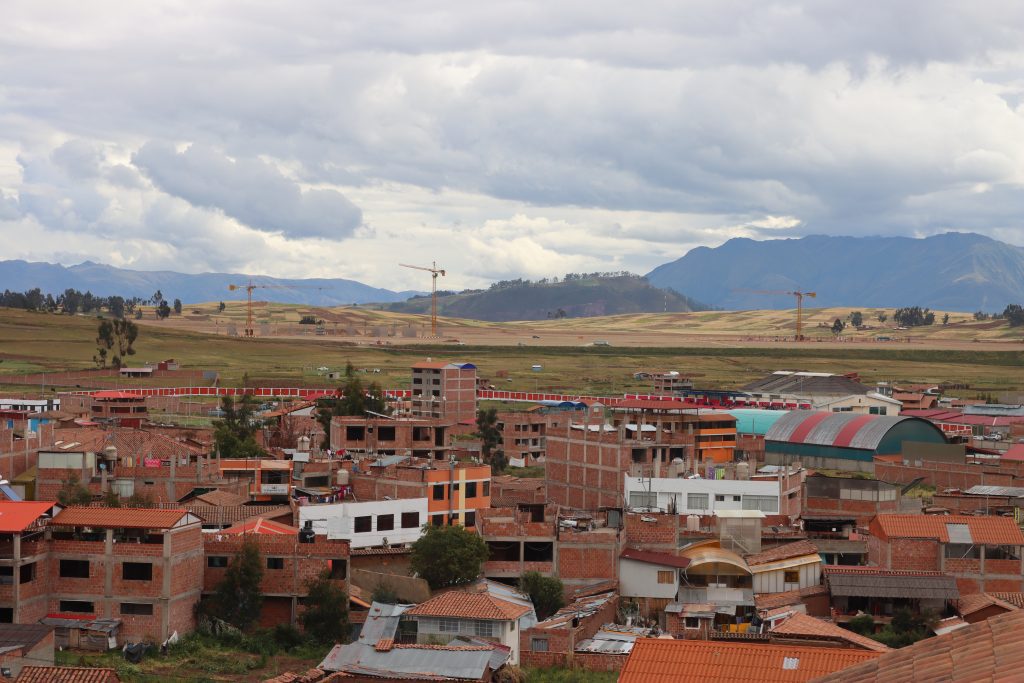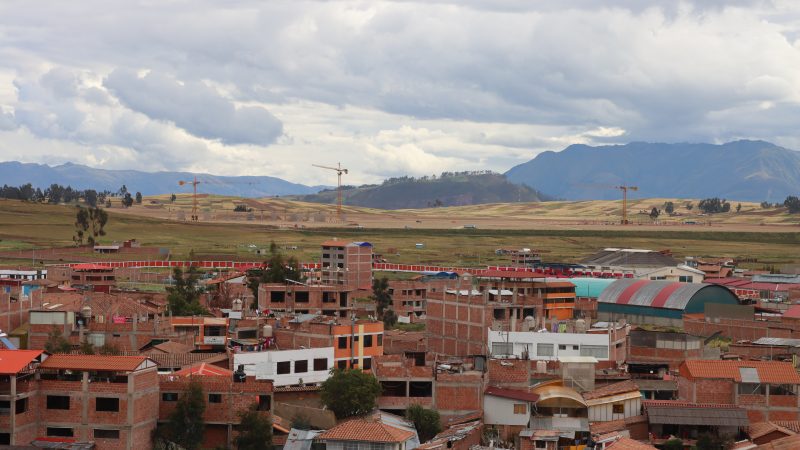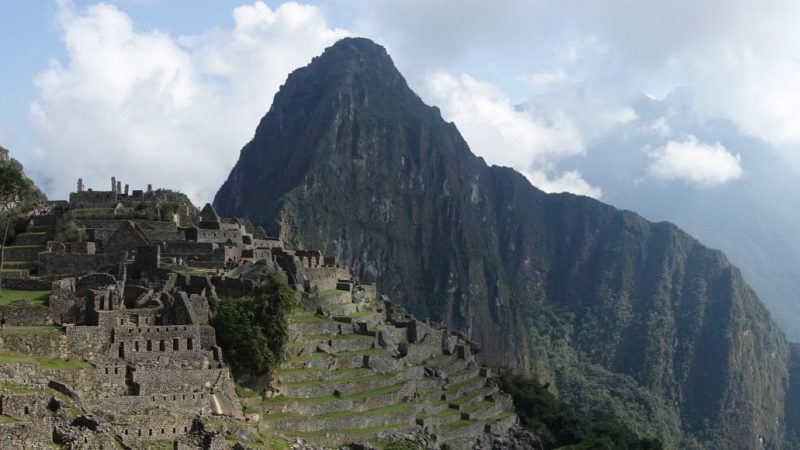This essay was submitted in 2022 as coursework toward a Master of Science degree in Sustainable Development. All work belongs to the website author.
Featured image of Chinchero village with airport construction site in background (May 2023) by Draceane, CC BY-SA 4.0, via Wikimedia Commons
Introduction
The Cusco region is located in the Andean highlands of south-central Peru, and its capital city of the same name was once capital of the Inca Empire. It is among the most visited regions of Peru, and Cusco’s old city and Machu Picchu (in the Sacred Valley) were designated UNESCO World Heritage Sites in 1983. The local economy is unsurprisingly highly dependent upon tourism, with Machu Picchu alone welcoming nearly 1.6 million visitors in 2018 (Peru Telegraph, 2019).
The region is currently served by an airport in the city of Cusco which was built in 1965 and which many consider outdated; proposals for a new airport in the nearby village of Chinchero date back to the late 1970’s (Berti, 2019). The plans were shelved due to political violence, economic issues and corruption, but were revived in 2010 (Martorell, 2021; Connolly, 2021). After several years’ delay involving project financing and land transfer conflicts with the first developer, a South Korean led consortium took over and land-clearing began in 2019, paused in 2020 during the pandemic and resumed in late 2021 (EIU, 2017; Collyns, 2019; Connolly, 2021). The project is expected to cost $640m (2021 est.), will initially open with a capacity of 5.7 million annual travelers, expandable to 8 million which is a nearly fourfold increase over the limit of the existing facility (Tegel, 2014; Rogers, 2021). Its planned completion is in 2025, when tourism in the region is anticipated to have achieved a full recovery (Connolly, 2021).
Chinchero is a 600-year-old village with approximately 10,000 mostly indigenous residents, located 30 kilometers northwest of Cusco along the route to the Sacred Valley. The indigenous population consists largely of members of three different ayllus (family groups): the Yanacona, Cúper and Ayllopongo (Garcia, 2020). Its economy was historically based upon agriculture, but the growth in tourism in the 21 st century in particular caused a shift, such that tourism now generates the largest share of local incomes through, for example, the sale of handicrafts (particularly textiles) and tour guide services (Garcia, 2015).
This paper will analyze the conflict surrounding the project, and will be organized into three sections. First, I will offer an overview of the various actors, their arguments for and against the project, and some of the key events and impacts that have been noted thus far. Second, I will evaluate the conflict using a policy processes and discourses approach, looking at how state actors exercised their authority and favored the dominant neo-liberal discourse that has systematically denied indigenous communities’ agency over their own economic development. Finally, I will explore how the pathways to sustainability framework could open up alternative development paths that are currently obscured by powerful political and economic interests.
Conflict Information and Evaluation
Since its initial conception the project has been beset by numerous controversies. Proponents include the regional and national governments, local workers’ unions and the Chinchero District mayor, all of whom tout its expected economic benefits for the region (Connolly, 2021). After faltering for decades, the convergence of national and regional governments run by the same political party (Partido Nacionalista) together with a growing national focus on tourism development allowed the project to advance (Garcia, 2020). Successive governments continue to support the project, including that of the current President, Pedro Castillo (Partido Político Nacional Perú Libre), who attended the latest groundbreaking ceremony in November 2021 (Rogers, 2021).
The arguments against the project are numerous and varied. One very practical but serious issue concerns the chosen site, which creates or exacerbates safety risks for travelers. Aviation safety experts have produced reports as far back as the 1980’s, stating that the altitude, climatic conditions and surrounding topography make the location dangerous for aircraft, and claiming that constructing an airport in this location would put lives at risk (Berti, 2019). Additionally, a study found that one in five travelers to Cusco’s airport (at 3,310 meters elevation) reported having to alter their travel plans due to acute mountain sickness (Salazar et al., 2012), a figure which may rise if the airport is relocated to Chinchero’s dizzying 3,720 meters above sea level.
Second, the project risks impacting numerous sensitive ecological environments and Inca ruins/archaeological sites. Anticipated impacts to archaeological sites include the destruction of Inca terraces and trails on the site, as well as noise and air pollution from planes that will fly low over nearby Sacred Valley sites such as the ancient pueblo and ruins of Ollantaytambo (Collyns, 2019). One of the feared ecological impacts concerns the region’s hydrology. Chinchero is very dry during the winter season, but its ecosystem of wetlands, springs and lagoons keeps the area’s fertile soil irrigated and provides water to the region. One hydrologic study found, however, that the project’s Environmental Impact Assessment (EIA) contained numerous deficiencies, errors and false statements, and was judged to be wholly insufficient in both its qualitative and quantitative analysis, thus putting the entire hydrologic system at great risk (Soria Dall’Orso, 2020).
A third point of controversy involves alleged corruption among the political and economic elites who have championed the project. The land on which the existing Cusco airport sits is many times more valuable than the terraced farmland in Chinchero, and politicians and business leaders are keen to redevelop the current airport site at what is likely to be significant profit, resulting in accusations of forcing the project through while ignoring the risks involved (Asheshov, 2017). Allegations of corruption and price hikes on the part of local leaders were also leveled in regards to Kuntur Wasi, the first firm that was granted rights to build and operate the airport (Asheshov, 2017; Collyns, 2019). Misrepresentation of the airport’s purported benefits has also occurred; after claiming otherwise for years, in 2019 the Peruvian Ministry of Transport was forced to confirm the truth of criticism from the International Air Transport Association (IATA) that the airport would not be able to handle transoceanic flights as promised (Gestión, 2019).
A fourth less tangible yet far-reaching impact is upon the communities in and around Chinchero. The ayllus are divided on the project, with a spectrum of views. Some see it as a positive sign of progress and economic development, while others are either wary or against it due to concerns about its impact on their lives and land (Garcia 2017, 2020; Connolly 2021). Garcia (2020) details the social change already experienced by the indigenous communities in the area following the sale of previously communally-owned lands, which resulted in conflicts between and within families concerning the disbursement of proceeds, and the splitting of lands that both literally and figuratively separated comuneros (community members) who previously had shared ritual and social practices on the land. These events have already had a transformative effect on the sense of identity and concepts of ‘indigeneity’ among comuneros, and:
these transformations seem only to reaffirm the power of (tourism) infrastructure and development to encourage the emergence of new identity politics that may well contest and contradict previous and cherished assumptions…about what being ‘indigenous’ is or should be about (Garcia, 2020, p. 169).
As a result of divided opinions and lack of political clout, there has been very limited organized protest on the part of Chinchero’s residents. One exception is Rocío Cjuiro Mescco, who gathered more than 20 of her neighbors to write a letter to the local government protesting the use of water from a nearby lagoon without permission by the company conducting landclearing, an effort referred to as “…in many ways, an uphill battle—against corporations, government entities, and even some of her own neighbors” (Connolly, 2021).
Opposition to the project has been particularly strong from the international and academic communities, however. UNESCO filed a formal request for a Heritage Impact Assessment concerning Machu Picchu to the Peruvian government in 2019, a request that to date has not been met (UNESCO, 2021). Natalia Majluf, a Peruvian-born art historian at Cambridge University, also started a Change.org petition which has gathered well over 100,000 signatures worldwide, and claims that “I don’t think there’s any significant archeologist or historian working in the Cusco area that hasn’t signed the petition,” (Collyns, 2019).
Policy Processes and Discourses Approach
Using the policy processes and discourses approach, it becomes apparent that the national and regional governments have used policy as an instrument of power (Shore and Wright, 1997, cited in Keely and Scoones, 1999). But key to understanding this behavior is understanding the country’s recent development history. Peru has, beginning in earnest with the Fujimori government in 1990, doggedly pursued a neo-liberalist development model, including large-scale privatization of assets and opening of the economy to foreign direct investment, resulting in a predominance of interests related to extractive industries and a notable lack of environmental governance (Pieck, 2015). The Fujimori era (1990-2000) led to rapid economic development, but his was also a highly controversial regime that “carefully cloaked its authoritarian behavior in democratic forms” (Carrión, 2006, p.5). Carrión (2006, p. 103) also highlights the degree of economic hegemony held by elites:
…made possible by the official culture of impunity. …the Fujimorista elite constructed its own immoral economy, one based on maximizing the economic spoils of power and structured deceit.
While Fujimori’s government was ousted more than two decades ago, its legacy endures and many of his neoliberal policies were upheld by successors such as Garcia and Toledo (Pieck, 2015).
The literature on state-centered accounts of vested political interests driving the policy process apply strongly to this case, in particular the concept of “active states pursuing concrete projects”, regardless of whether or not the goals they pursue through policy reflect prevailing societal interests (Keeley and Scoones, 1999, p. 15). The above-mentioned allegations of corruption perhaps help to explain the seemingly irrational continuation of a project that, when viewed objectively, appears in many ways ill-advised.
When reflecting upon indigenous rights using a policy processes and discourses lens, it is important to consider how the 2013 sale of Yanaconda land to the Cusco regional government took place. Before negotiations even started, Peru Official Law 29908 was signed, specifically allowing the expropriation of land for the project (DePeru.com, 2012). Also prior to the start of negotiations, the government succeeded in arguing that Chinchero was not an indigenous town due to it being too urbanized, thus stripping the Yanaconda of protections such as rights to an informed decision and prior consultation that they would have normally been entitled to under UN Convention terms and declarations in favor of Indigenous Peoples and the International Labor Organization (Garcia, 2020). In parallel to these actions, a propaganda campaign involving intense media pressure had been underway for some time already, and that control of the narrative together with the strategic withholding of information that could trigger opposition proved very effective in gaining the acquiescence of Yanaconda comuneros. This strategy is addressed directly by two theories of power, that it is wielded by controlling the agenda and also by “ensuring that the marginalised are not even aware of their interests” (Keeley and Scoones, 1999, citing Lukes, 1975, p. 28). As Garcia (2020) indicated, in the absence of real alternatives, many of Chinchero’s residents have trusted the promise of economic prosperity that they were told the airport will bring. Others are cynical, as evidenced by this powerful quote from a Cúper elder expressing frustration with the duality of protection and exploitation:
…what is the use of having my peasant and comunero identity if I do not have the means to educate my sons as I would like to? … The state and those foreigners want us to keep our customs, our social and political organisation systems. That is why they promulgated the Law of Indigenous Communities that acknowledges our different reality and rights. This way it looks like they are supporting us but in reality they are keeping us poor (Garcia, 2020, p. 166).
Envisioning Alternative Pathways to Sustainability
One might consider the halting of construction an ideal outcome, but this is unlikely considering the degree of project lock-in that has already occurred. But beyond pure fanciful imagination, there are valid reasons to employ the pathways approach to consider how this policy issue could have been handled differently. It could help facilitate more inclusive future decision-making processes, and it could also enable better future decisions for this project, perhaps minimizing its negative impacts.
For example, the Ministry of Transport’s stated goal is to improve Cusco’s airport infrastructure, thereby increasing the volume of tourism to the region and, secondarily, promoting regional development (Martorell, 2021). But what if, instead of focusing on transport infrastructure alone, the Ministry were tasked with enhancing mobility through the lens of the Latin American concept of ‘Buen Vivir’ (See Figure 1) (Hidalgo-Capitán, 2017)? Such a reframing of thinking about mobility could allow alternative narratives to emerge, particularly from those whose voices were obscured by the dominant perspectives, and allow new pathways to sustainable transport development to open up (Demeritt, et al, 2011).

Figure 1: The intellectual wellsprings of Latin American Good Living (Hidalgo-Capitán 2017, p. 31).
Conclusion
The conflict surrounding the Chinchero Airport project is representative of the challenges that arise when powerful political and economic interests collide with themes of cultural heritage, environmental justice and marginalized citizens’ rights. As the world seeks to meet the challenges set by the Sustainable Development Goals, the need to recognize how existing power structures and their discourses have failed to plot a sustainable course will grow. New ways forward, such as that suggested by the STEPS Centre Pathways to Sustainability, are key to opening policy discourse and augmenting the voices that have thus far gone largely unheard.
Bibliography
Asheshov, N. (2017) ‘Chinchero – Lost in the Clouds of Poor Engineering, Bad Finance’, Andean Air Mail & Peruvian Times. Available at: https://www.peruviantimes.com/26/chinchero-lost-in-the-clouds-of-poor-engineering-badfinance/27805/ (Accessed: 22 June 2022).
Berti, A. (2019) ‘Saving Machu Picchu: will a new airport create problems in Peru?’, Airport Industry Review, (49). Available at: https://airport.nridigital.com/air_nov19/saving_machu_picchu_will_a_new_airport_create_ problems_in_peru (Accessed: 20 May 2022).
Carrión, J.F. (2006) The Fujimori Legacy: The Rise of Electoral Authoritarianism in Peru. University Park: Penn State University Press.
Collyns, D. (2019) ‘’It would destroy it’: new international airport for Machu Picchu sparks outrage’, The Guardian. Available at: https://www.theguardian.com/cities/2019/may/15/archaeologists-outraged-over-plans-formachu-picchu-airport-chinchero (Accessed: 22 June 2022).
Connolly, C. (2021) ‘The Uphill Battle to Stop Peru From Building a New Airport Near Machu Picchu’, Smithsonian Magazine. Available at: https://www.smithsonianmag.com/travel/uphill-battle-to-stop-peru-from-building-newairport-near-machu-picchu-180977088/ (Accessed: 24 May 2022).
Demeritt, D. et al. (2011) ‘Pathways to Sustainability: Perspectives and Provocations’, Environment and planning. A, 43(5), pp. 1226–1237. doi:10.1068/a227sym.
DePeru.com. (2012) Legislación del Perú: Ley Nº 29908. Available at: https://www.deperu.com/legislacion/ley-29908-pdf.html (Accessed: 23 June 2022).
Economist Intelligence Unit (EIU) (2017) ‘Chinchero Airport project gets the go-ahead’, 8 February. Available at: http://country.eiu.com/article.aspx?articleid=65095590&Country=Peru&topic=Economy&su btopic=Forecast&subsubtopic=Fiscal+policy+outlook&u=1&pid=1775178961&oid=17751789 61&uid=1 (Accessed: 21 June 2022).
Garcia, P. (2017) ‘Ruins in the landscape: Tourism and the archaeological heritage of Chinchero’, Journal of material culture, 22(3), pp. 317–333. doi:10.1177/1359183517702932.
Garcia, P. (2020) ‘Indigeneity in the Air: The Case of Chinchero Airport in Cusco, Peru’, Bulletin of Latin American research, 39(2), pp. 157–171. doi:10.1111/blar.12743.
Gestión (2019) ‘Chinchero: MTC confirma que aeropuerto no fue diseñado para vuelos transoceánicos’, 28 June. Available at: https://gestion.pe/economia/chinchero-mtcconfirma-aeropuerto-disenado-vuelos-transoceanicos-271708-noticia/ (Accessed: 22 June 2022). Hidalgo-Capitán, A.L. and Cubillo-Guevara, A.P. (2017) ‘Deconstruction and Genealogy of Latin American Good Living (Buen Vivir). The (Triune) Good Living’, Revue internationale de politique de développement, (9), pp. 23–50. doi:10.4000/poldev.2351.
Keeley, J. & Scoones, I. (1999) Understanding Environmental Policy Processes: A Review, IDS Working Paper 89, Brighton: IDS.
Martorell, A. (2021) ‘Defending the Sacred Valley of the Incas Against Misguided Tourism Development’, in Niglio, O., Lee, E.Y.J. (eds) Transcultural Diplomacy and International Law in Heritage Conservation. Springer, Singapore. doi:10.1007/978-981-16-0309-9_18.
Peru Telegraph (2019) ‘How many tourists visited Machu Picchu in 2018?’, 19 March. Available at: https://www.perutelegraph.com/news/peru-travel/how-many-tourists-visitedmachu-picchu-in-2018 (Accessed: 20 June 2022).
Pieck, S.K. (2015) ‘“To be led differently”: Neoliberalism, road construction, and NGO counter-conducts in Peru’, Geoforum, 64, pp. 304–313. doi:10.1016/j.geoforum.2013.06.011.
Rogers, D. (2021) ‘Work starts today on $640m airport for Machu Picchu’, Global Construction Review. Available at: https://www.globalconstructionreview.com/work-startstoday-on-640m-airport-for-machu-picchu/ (Accessed: 22 June 2022).
Salazar, H. et al. (2012) ‘Acute Mountain Sickness Impact Among Travelers to Cusco, Peru’, Journal of travel medicine, 19(4), pp. 220–225. doi:10.1111/j.1708-8305.2012.00606.x.
Soria Dall’Orso, C. A. M. (2020) ‘Los humedales en la evaluación de impacto ambiental del propuesto aeropuerto de Chinchero’, Revista Kawsaypacha: Sociedad y Medio Ambiente, (5), 11-33. Available at: https://revistas.pucp.edu.pe/index.php/Kawsaypacha/article/view/22656/22057 (Accessed: 23 June 2022).
Tegel, S. (2014) ‘Ruining the ruins? Machu Picchu gets an airport’, Toronto star, p. WD7–.
UNESCO (2021) State of Conservation: Historic Sanctuary of Machu Picchu 2021. Available at: https://whc.unesco.org/en/soc/4227 (Accessed: 22 June 2022).





This Post Has One Comment
Pingback: Why is the Sacred Valley’s new airport project so controversial? - Wanderlust for Life